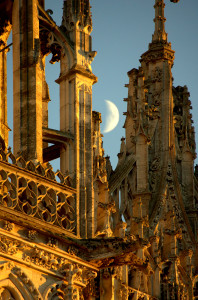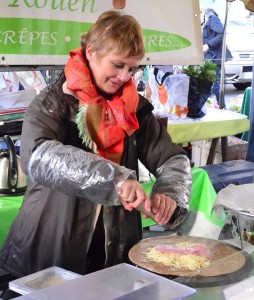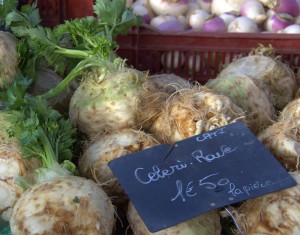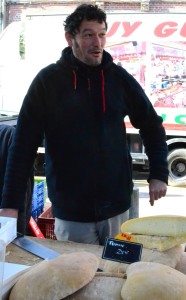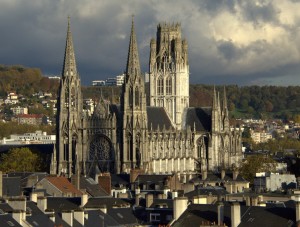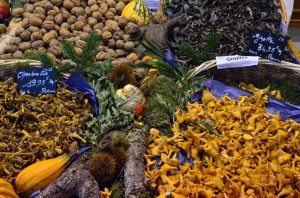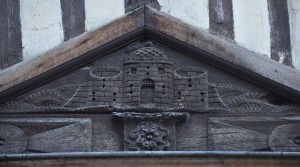There are places where la douceur du climat (the mildness and sweetness of the climate) of France makes it possible to enjoy the good life year-round—and within an easy train ride of Paris. Take, for instance, Rouen especially on a Sunday morning when the city’s two largest markets are running full tilt and the cathedral inspires awe in parishioners and tourists with its ancient rituals. Brian Pfeiffer, an architectural historian and self-trained gastronome, contributes this guest post describing some of his favorite stops in Rouen. If you follow in his footsteps, I promise you won’t be disappointed. ~Marjorie
Rouen—Walking & Eating Tour
Text and photos by Brian Pfeiffer
From the Middle Ages through the 18th century, Rouen was one of the most important commercial centers of Europe due to its location on the Seine, where it controlled shipping to Paris, and due to its industrious weavers who converted English wool to fabrics sold throughout Europe. Rouen is loaded with architectural treasures from its Mediaeval and Renaissance past as well as twelve open-air markets selling everything from locally produced food to clothing and bric-a-brac.
Don’t be put off by initial impressions as the train from Paris arrives at its basement level platform in the city’s main train station (Gare de Rouen-Rive-Droite). Press on up the stairs and you will arrive at an Art Nouveau building that was stylish and even a bit avant-garde in its concrete construction when designed in 1913.
But first things first – the ambitious walker needs to be well nourished, architecturally and gastronomically. Go down rue Jeanne d’Arc and turn left onto rue du Gros Horloge, where there’s an elaborate Renaissance-style tower constructed in 1529. The clockwork and the quaint quarters occupied by the keeper of the clock enliven the climb to the tower’s roof and its magnificent view of Rouen’s medieval rooftops, cathedral, and spires.
Continuing on, the narrow street opens into a small square dominated by the façade of the Cathédrale Notre-Dame de Rouen, celebrated in the paintings of Claude Monet.
I notice the door ajar, and a small service going on inside. Slipping in quietly, I stand at the back and enjoy the great mediaeval interior as well as the service, albeit reduced in scale from the pageantry that once prevailed when the cathedral would have been filled during masses.
A few more blocks’ walk takes you to the place Saint-Marc, where more than 200 vendors gather on Sundays to sell everything from fish and vegetables at the north end of the market to clothing and second-hand furnishings at the south end. Prepared food of all sorts abounds. The stand “C’est Maman qui la Fait à Rouen” makes buckwheat galettes filled with ham and grated cheese and cooked to a crisp delight on an iron griddle before being wrapped in a cone of paper for the ambling diner.
Vats steam with other delights: choucroute, an Alsatian dish made of sauerkraut, sausages and smoked meats, and tartiflette, a casserole of potatoes, smoked bacon, cream, and Reblochon cheese adopted from Haute-Savoie – both of which have been nearly made native by the Rouennais.
Au Panier de la Ferme, operated by Monsieur et Madame Humel Laurent, offers spectacular seasonal produce. They sell at five markets per week and welcome visitors to their farm where it’s grown. Beeswax, honey, and confections made from it can be found at the stand of L’Ermitage des Abeilles on the east side of the market next to the stand of Philippe Desert who grows cresses which you can buy in fresh abundance or as prepared soups packed to go.
Organic food production in Haute-Normandie seems to have taken root firmly, although some producers claim that they have not converted to organic methods – they simply never abandoned them. Among the more interesting and easily transported of these products are the Saucissons Roches-Blanches, a small association of two farmers and a charcutier committed to producing saucissons secs (dry-cured sausages) using traditional methods and locally raised pork. The results speak for themselves. Equally good is sheep’s milk tomme sold by a cheerful fromager who, like most vendors, conveys enormous enthusiasm for his products and his work.
With food in stomach, and perhaps in rucksack, the time comes to turn attention to architecture. There are few more interesting or unusual places to start than the Aître Saint-Maclou, entered through a small passage at 186 rue Martainville. A mass burial site in 1348 when three-quarters of the city’s population died from plague, the cemetery was pressed for space again by an outbreak of plague in the 1520s. Bones from earlier burials were exhumed and three sides of the present quadrangle were constructed as an ossuary to clear the center of the quadrangle for mass burials. The dark remembrance of this period of European history is preserved in the macabre woodcarvings of shovels, skulls, and the dance of the dead that decorate the courtyard which now serves as an art school.
Next to the Hôtel de Ville, the former Abbatial Church of Saint Ouen presents an impressive Gothic interior on the scale of a cathedral.
The church now serves as a venue for exhibitions, but it retains stained glass windows from the 14th and 15th centuries. Don’t overlook the hand-wrought iron grilles in the Rococo style added to the choir in 1738 and 1747 by Nicolas Flambart, a Parisian artisan of considerable skill.
Nearby, the former Church of Saint-Laurent was another of the vast number of church properties confiscated during the Revolution and sold, often at auction, for “le bien nationale” (public benefit). In 1803, this church went to the highest bidder who converted it to a stable. In 1921, it re-opened as Le Secq des Tournelles Musée de la Ferronnerie (Museum of Ironwork) housing an exceptional collection of hand-wrought ironwork. It is easy to get lost in this collection of more than 16,000 items including old signs, ornamental grilles, lanterns, locks, instruments, and just about anything else ever made of iron.
Despite the ravages of war, Rouen preserves an astounding number of half-timbered houses and stone merchants’ houses from the 16th to 18th centuries. The densest collection of these buildings is found in the streets surrounding the place du Vieux Marché (the Old Market Square) where Joan of Arc was burned alive in 1431. This gruesome event is commemorated by a Modernist poured concrete church and a market hall where vendors sell oysters, produce, charcuterie, and prepared foods from permanent market stalls that are open daily.
My favorite route heads north of the square where narrow streets are lined with ancient houses displaying coats of arms and naively executed Renaissance-style carvings from the late 16th and early 17th centuries. Few please me as much as the half-timbered house at 68 rue Cauchoise (1602) with its beehive carving that proclaims either the owner’s industry or connection to Freemasonry, just as its ungainly Ionic pilasters reveal the owner’s wish to display his worldliness.
As the end of the day approaches, I return to the place du Vieux Marché and the shop La Chocolatière at 18, rue Guillaume le Conquérant, where a Roméo punctuates the stroll. Their Roméo cake is two layers of gênoise soaked with rum syrup, held together with vanilla butter cream studded with rum-soaked raisins and covered with a beautiful fondant glaze. In this era of health-food faddism, there may be those who would apply such useless phrases as “too sweet,” “too much butter,” or “too boozy” to the cake. Don’t listen to such voices; they lack the Zen mastery of the essence of pastry, that ability to taste through the sugar to the soul of the thing. Nibble small pieces and balance them with sips of unsweetened espresso, after which you will find you have plenty of energy for the fifteen-minute walk back to the train station and the 1¼ hour journey to Paris and dinner.
Further Details
How to Get There: Rouen is easily reached from Paris from the Gare Saint-Lazare. Direct trains take between 1 hour 15 minutes and 1 hour 33 minutes depending upon the service and number of stops. Availability and prices can easily be checked online (discounted fares start around 10 Euros each way). The information window in Rouen’s train station can provide a useful pocket map of the city center. Note that the return trains to Paris can get crowded starting about 5 pm on Sunday, so consider making a return reservation if going for a Sunday day trip.
Christmas Market (Marché de Noël), starting early December through the holiday season, where generous portions of tartiflette and choucroute are served up at cheerful communal tables in a tent directly in front of the cathedral.
For more on the history of Rouen, click here and consult this list of local monuments, museums, and opening hours.
Brian Pfeiffer is an architectural historian who lives in Cambridge, Massachusetts, where he plots his frequent escapes to Paris and its environs in search of architectural and gastronomic treasures.
Related Posts:
Riches of Versailles: An Eating & Walking Tour
Salon du Chocolat in Paris
Pâtisserie Aurore-Capucine


